Deposits and Erosions
Both deposit and erosion contact surfaces are useful for modelling sheet-like contact surfaces. The primary lithology is on the young side and the contacting/avoided lithologies are on the older side. The processes for creating deposit and erosion contact surfaces are the same; the difference between the two is how they interact with older volumes:
- Deposit contact surfaces do not cut older volumes, which results in a deposit volume that appears conformably on top of older volumes.
- Erosion contact surfaces cut away other contact surfaces on the older side of the erosion contact surface.
For a general introduction to how deposits and erosions interact with other contact surfaces, see Deposit and Erosion Contact Surfaces in the Building Surfaces Using the Surface Chronology topic.
Lithology data is often the most reliable data source to use when building geological surfaces, and it is best to derive contact surfaces from lithology data when it is available. If no lithology data is available, you can create deposits and erosions from other data in the project.
This topic describes creating and editing deposits and erosions. The topic is divided into:
- Creating Deposits/Erosions From the Base Lithology
- Deposits and Erosions From Other Lithology Contacts
- Deposits and Erosions From Other Data
- Deposits/Erosions in the Project Tree
- Switching Between Deposits and Erosions
- Refining Deposits and Erosions
- Surfacing Options for Deposits and Erosions
- Applying a Trend to a Deposit/Erosion
Creating Deposits/Erosions From the Base Lithology
There are two ways to create contact surfaces from lithology data:
- Using the base lithology column assigned when the model was created. This is the process described below.
- Using other lithology information available in the project. This is useful when you have created an additional lithology column as part of correcting and working with the drilling data or have multiple drilling data sets in your project. For example, if when building a geological model it becomes apparent that changes need to be made to the drilling data, you can import additional data or create a new column using the split lithology, group lithology or interval selection tools. See Deposits and Erosions From Other Lithology Contacts below for more information.
Selecting the From Base Lithology option opens the New Contact Points window:
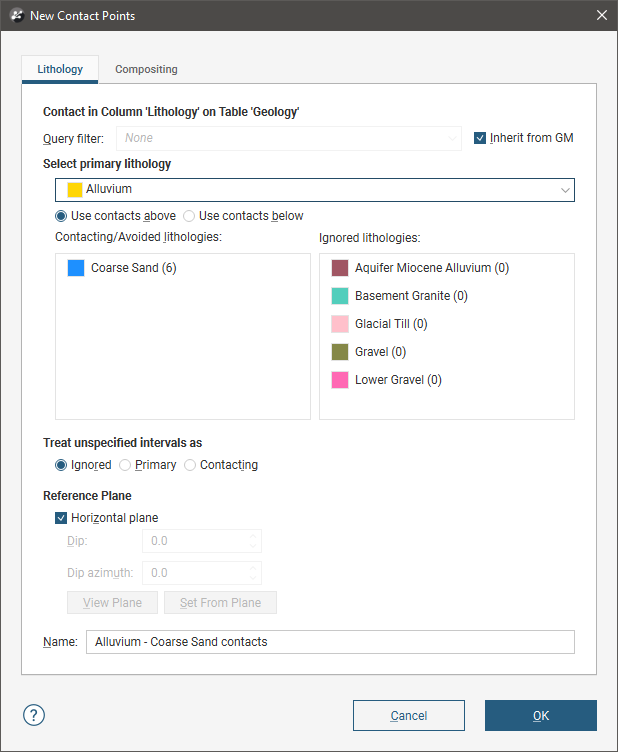
Select the lithology you wish to use to create the surface from the Select primary lithology list; this will be the older lithology (lower down) in the geological model. The Contacting/Avoided lithologies list shows the lithologies that contact the primary lithology and the number of contacts. This helps in selecting which contacts to use to create the contact surface.
By default, Leapfrog Energy will show the contacts above the primary lithology, but you can use the Use contacts below option when, for example, one lithology is interbedded with another. Here we can see that the coarse sand is interbedded with alluvium:
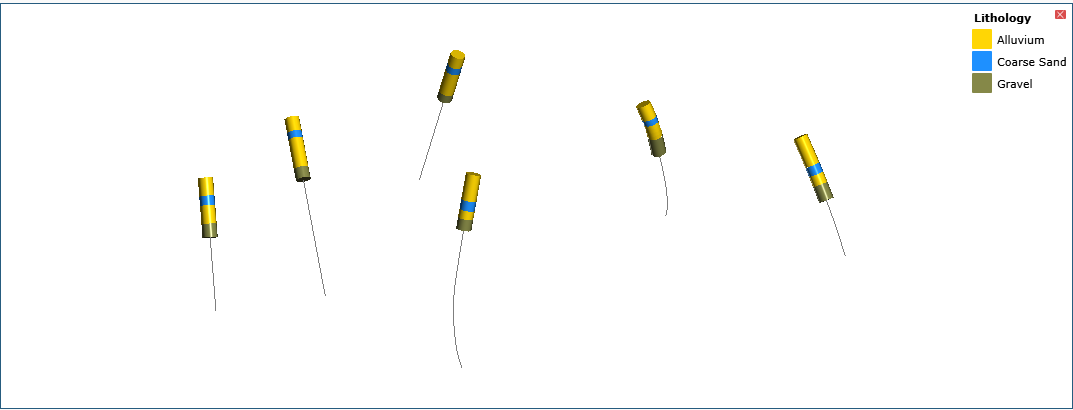
The solution to this is to create two surfaces from the Alluvium contacts, one using the contacts above (younger contacts) and the other using the contacts below (older contacts):
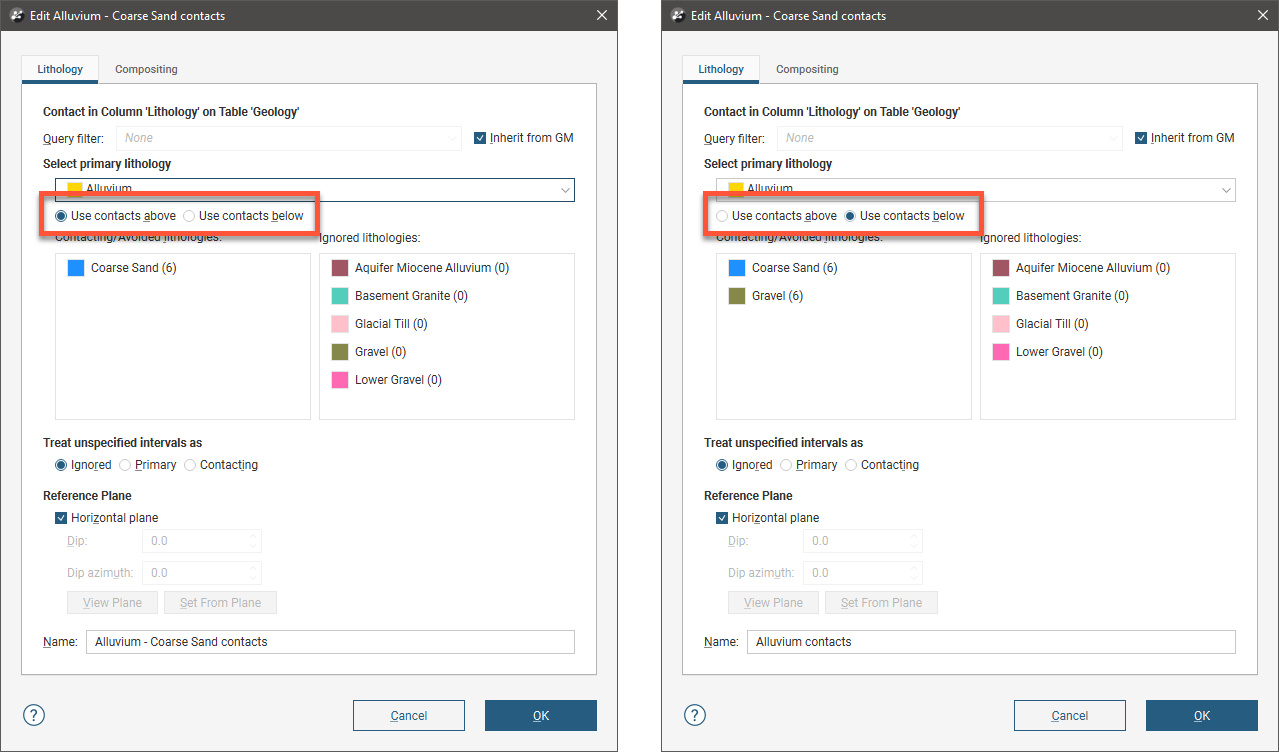
Note that the gravel contacts should be excluded for the surface created from the Use contacts below option, as we can see from the drilling data that gravel appears lower down in the model than the surface we are creating. Do this by dragging the contacts that should be excluded to the Ignored lithologies list:
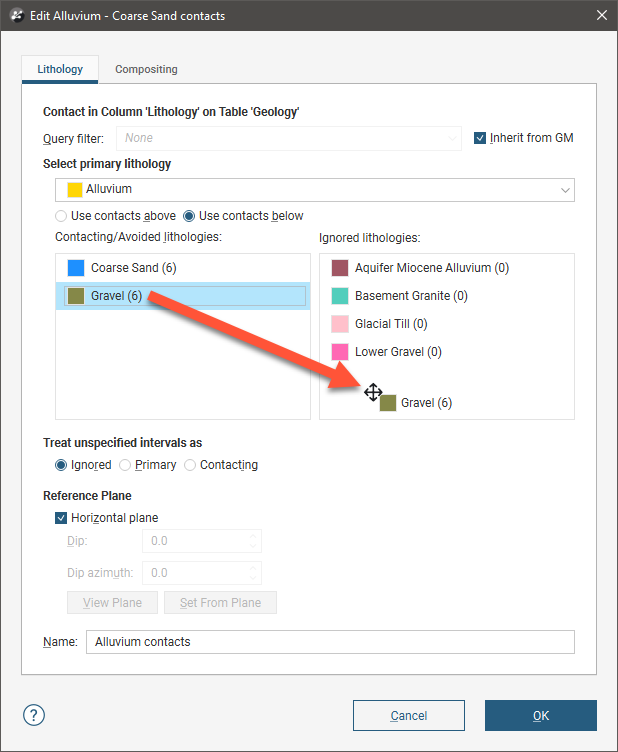
Unspecified intervals are intervals that have no data. By default, unspecified intervals are ignored when creating a contact surface, but you can also treat them as the primary lithology or as avoided lithologies.
For complex geologies, the up and down directions for the surface may not be clear. If this is the case, untick the Horizontal Plane box. A reference plane will appear in the scene, with the up-facing surface labelled A and the downward-facing surface labelled B:
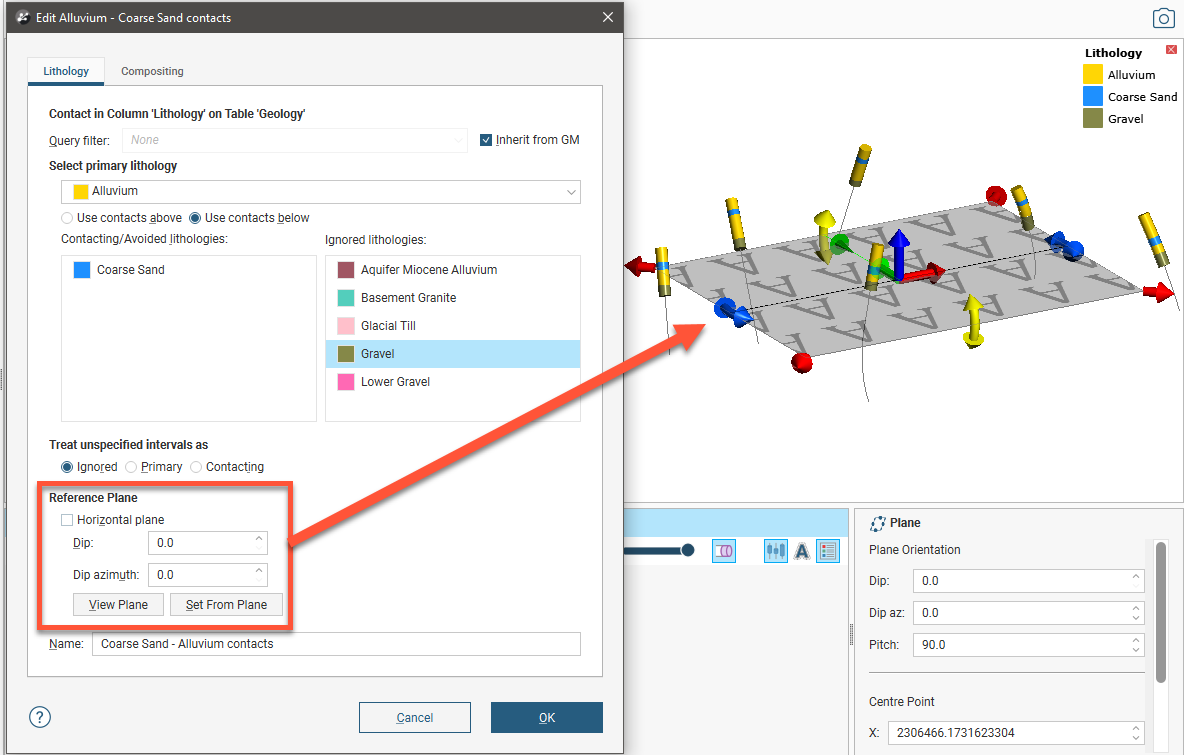
When you disable the Horizontal plane option for the Reference Surface, the number of contacts is longer displayed in the lithologies lists, as the number of contact points is not updated when the reference surface used changes.
Controlling the position of the reference plane is similar to controlling the position of the moving plane:
- Use the handles in the scene window to move the plane.
- Set the Dip and Dip Azimuth values in the New Contact Points window. The reference plane will be updated in the scene.
Once the reference plane is correctly oriented, click the Set From Plane button.
Setting a reference plane for contact points is different from applying a global trend to a surface. To apply a global trend to a surface, double-click on the surface in the project tree and click on the Trend tab. See Global Trends in the Trends and Anisotropy topic for more information.
Data can be composited at the well level or on a surface-by-surface basis. To composite the data used to generate the contact surface, click on the Compositing tab. See Category Composites for more information.
Click OK to create the contact surface, which will appear in the project tree under the Surface Chronology. See Refining Deposits and Erosions below for more information on refining the contact surface.
Deposits and Erosions From Other Lithology Contacts
Creating deposit and erosion contact surfaces using the From Other Contacts option is useful when you have created an additional lithology column as part of correcting and working with the drilling data or wish to make use of lithology data in another drilling data set. For example, if when building a geological model it becomes apparent that changes need to be made to the drilling data, you can import additional data or create a new column using the split lithology, group lithology or interval selection tools. See Splitting Lithologies, Grouping Lithologies and Selecting Intervals for more information.
The process is similar to creating a surface from the base lithology column, but you must first select the lithology column you will use:
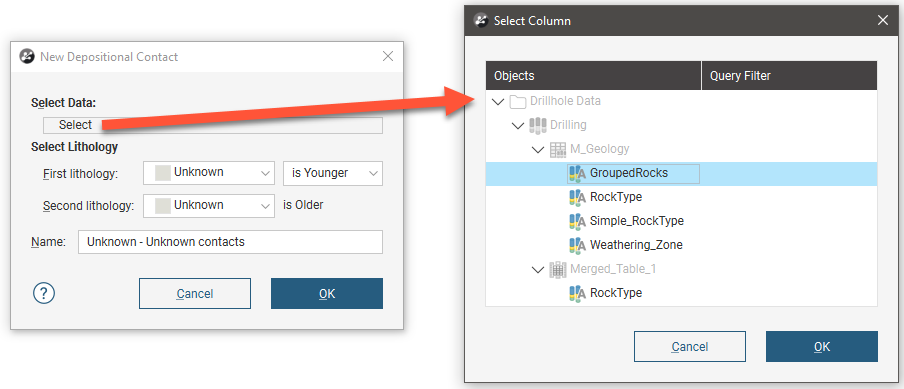
Select the First Lithology and Second Lithology, if known. Click OK. The New Contact Points window will appear. Assign the Primary lithology, Contacting/Avoided lithologies and the Ignored lithologies. These can only be selected from the model’s base lithology.
The rest of the process is similar to defining a contact surface from the base lithology. See Creating Deposits/Erosions From the Base Lithology above for more information.
Be sure to add the contact surface to the scene to view it and check that it is oriented correctly.
See Refining Deposits and Erosions below for more information on the different techniques that can be used for adjusting a contact surface.
Deposits and Erosions From Other Data
If suitable lithology data is not available, deposits and erosions can be created from other data in the project, such as GIS data, structural data, points, polylines and surfaces. The steps for creating deposits and erosions from other data are similar, regardless of the data used to create the surface:
- Right-click on the Surface Chronology and select one of the data types from the New Deposit/Erosion menu.
- Select the data object that will be used to define the surface. This must already be in the project, unless you are using a polyline, in which case you are given the option to create a new polyline.
- Select the First lithology and Second lithology. These are the lithologies that will be assigned to each side of the contact surface. The lithologies you can choose from are those defined for the geological model in the Lithologies object (see Geological Model Lithologies).
- Set whether the First lithology is older or younger than the Second lithology. Leapfrog Energy will, by default, put the younger side of a contact surface up, but this can be changed later.
Here, a points data object is being used to create a deposit:

For polylines, you first set the lithologies and the younging order, then click OK to move on to the next step:

You can draw the polyline in the scene directly by selecting the New Drawing option. You can also use any polyline in the project by selecting the Existing Polyline option. You can then select the required polyline from the list.
The new contact surface will appear in the project tree under the Surface Chronology. Add the contact surface to the scene to view it and check that it is oriented correctly.
If creating a surface from a new polyline, the polyline will not be able to be used elsewhere in the project unless it has been shared. To share the polyline, expand the contact surface in the project tree, right-click on the polyline and select Share. The polyline will then be available elsewhere in the project.
Deposits/Erosions in the Project Tree
The name Leapfrog Energy automatically assigns to a deposit or an erosion is the lithologies assigned to each side of the surface. In the project tree, expand the surface to see how it was made:
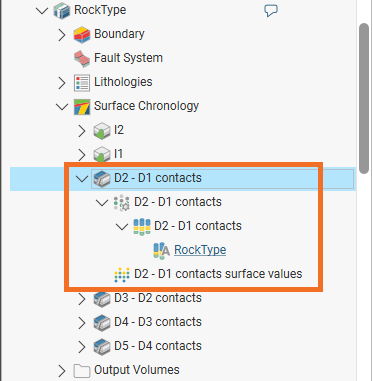
The surface shown above has been derived from lithology data and so the input is the contact points (![]() ). Also shown as part of the contact points are the lithology data the points are derived from (
). Also shown as part of the contact points are the lithology data the points are derived from (![]() ) and the surface values (
) and the surface values (![]() ). The surface values are the input points used in generating the contact points and are divided into four categories:
). The surface values are the input points used in generating the contact points and are divided into four categories:
- Drilling/point contacts. These are the contact points derived from lithology data and are equivalent to the contact points (
 ).
). - Polyline/structural contacts. These are derived from polylines or structural data, if any have been added to the surface.
- Off-surface points. These points are generated in determining the surface’s orientation and so dictate where the final contact surface will lie.
- Avoided points. These points are used to determine where the contact surface should not go.
The Properties window for the surface values object (![]() ) shows how many of each type of point have been derived:
) shows how many of each type of point have been derived:

These surface values can be displayed in the scene by category, which can help in understanding how the different types of input data are influencing the surface.
Although the surface values include avoided points, it is often more helpful to hide these points when displaying the surface values in the scene.
Double-click on the surface (![]() /
/![]() ) to edit it; this opens the Edit window for the surface:
) to edit it; this opens the Edit window for the surface:
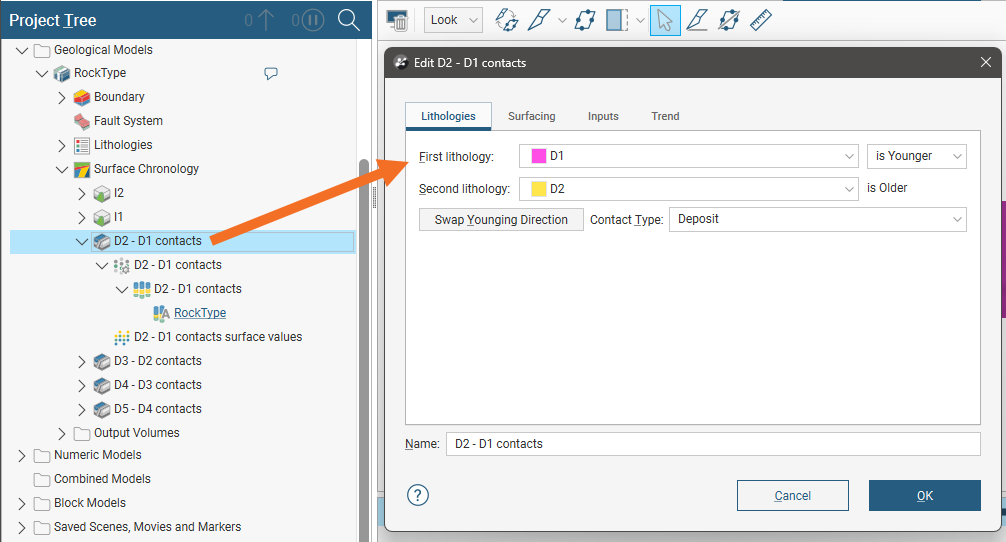
Double-click on the contact points object (![]() ) to edit the lithology and change compositing parameters.
) to edit the lithology and change compositing parameters.
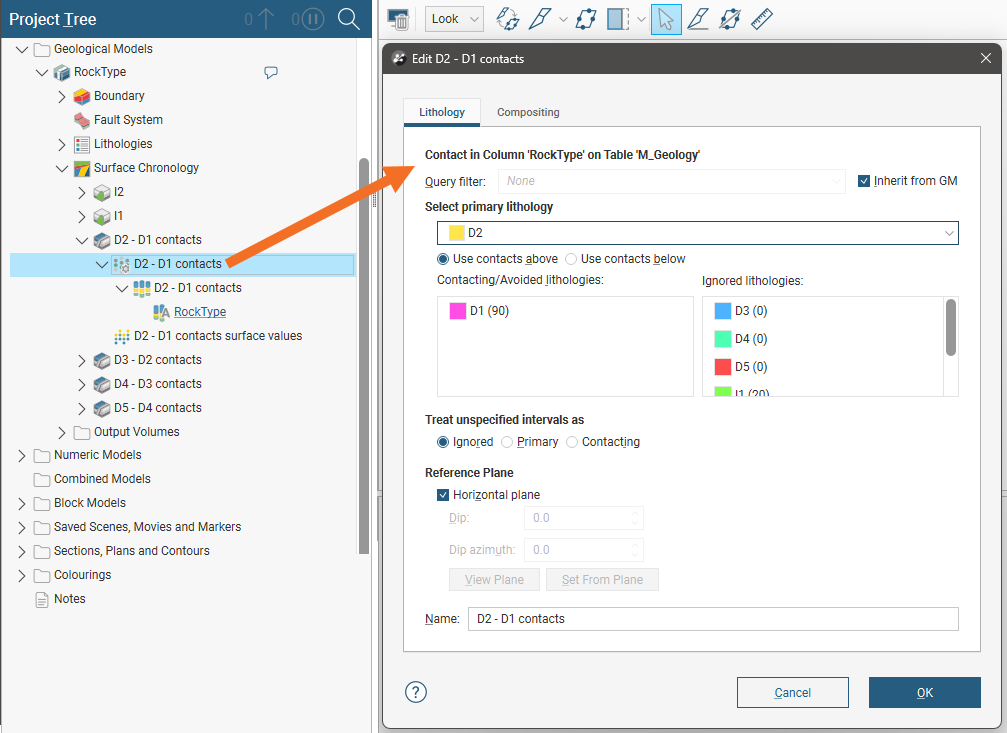
As further refinements are made to the surface, that information will also be added to the project tree.
You can copy deposits and erosions, which is useful in experimenting with the effects of different settings and in ensuring the consistency of settings across surfaces. To copy a deposit or an erosion surface, right-click on the surface in the project tree and select Copy. Enter a name for the copy, then click OK.
Contact surfaces can only be copied within a geological model; they cannot be copied to other models.
Copied surfaces are set to inactive in the Surface Chronology, so making a copy of a surface results in no processing changes to a geological model.
Switching Between Deposits and Erosions
If you are unsure whether to model a surface as a deposit or as an erosion, you can make a copy of, say, a deposit surface and easily change it to be an erosion surface. To do this, double-click on the surface in the project tree and in the Lithologies tab, change the Contact Type:

Refining Deposits and Erosions
You can refine deposits and erosions in several ways:
- Add other data. Right-click on the surface to see the options available, which will depend on how the surface was created. See Adding Data to Surfaces for more information.
- Edit the surface with a polyline. Right-click on the surface in the project tree and select either Edit > With Polyline. See Editing Surfaces With Polylines for more information.
- Edit the surface using structural data. Right-click on the surface and select Edit > With Structural Data. This option is available for deposits and erosions created from lithology data and other data in the project, but not for offset surfaces. See Editing Surfaces With Structural Data for more information.
To edit the surface’s settings, double-click on it in the project tree. In the Lithologies tab, change the lithologies assigned to each side of the surface, if required.
You can swap the younging direction if the direction was assigned incorrectly when the surface was created. The change will be reflected in the scene. Note that changing the younging direction does not change which lithology is older or younger.
The difference between deposit and erosion contact surfaces is how they cut older lithologies, as described in Building Surfaces Using the Surface Chronology. For this reason, it is possible to change between the two types using the Contact Type setting.
Surfacing Options for Deposits and Erosions
Surfacing options for deposits and erosions can be changed by double-clicking on the surface in the project tree and then clicking on the Surfacing tab. There are additional settings related to boundary filtering and snapping to data in the Inputs tab.
Boundary Filtering
When data objects are added to a surface, there are two ways to handle the data that lies outside the surface’s boundary:
- Filter the data. The surface is only influenced by the data that falls inside the surface’s boundary.
- Leave the data unfiltered. The surface is influenced by the data both inside and outside the surface’s boundary.
The Boundary filter setting determines how data used to define the surface is filtered:
- Inherit from GM. The setting for the geological model as a whole is used. This is the default setting.
- Off. Data is not filtered.
- All data. All data is filtered.
- Drilling only. Only drilling data and data objects derived from drilling data are filtered.
- Custom. Only the data objects specified in the Inputs tab are filtered.
Snapping to Data
Often, surfaces should honour drilling data and treat data objects such as polylines and GIS data as interpretations. See Honouring Surface Contacts in the Modifying Surfaces topic.
There is a Snap to data setting for a geological model as a whole that is set in the Geological Model > General tab (see Creating and Editing a Geological Model). Snap to data can also be set on a surface-by-surface basis by double-clicking on the surface in the project tree and then clicking on the Surfacing tab.
For individual contact surfaces, the options are:
- Inherit from GM. The setting for the geological model as a whole is used. This is the default setting.
- Off. Surfaces do not snap to the data used to create them.
- All data. Surfaces snap to all data within the Maximum snap distance, which includes drilling data and any data added to the surfaces.
- Drilling only. Surfaces snap to drilling data and data objects derived from drilling data within the Maximum snap distance but not to other data used to modify the surfaces.
- Custom. Surfaces snap to the data objects indicated in the Inputs tab for each surface.
Take care in enabling snapping and in selecting what data the surface will snap to, as the more data you include, e.g. by setting a large Maximum snap distance or selecting All data for Snap to data, the greater the possibility that errors in the data or assumptions inherent in interpretations (e.g. polylines) will cause distortions in the meshes. If you do enable snapping, it is best to snap only to drilling data. See Honouring Surface Contacts in the Modifying Surfaces topic for more information on these settings.
If you need a surface to honour drilling data but treat other data objects as interpretations, select Drilling only. To honour some data objects while treating others as interpretations, select Custom, then click on the Inputs tab to enable snapping for individual objects.
Setting the Surface Resolution
See Creating and Editing a Geological Model for information about the surface resolution settings in the Surfacing tab.
Setting the Surface Orientation
For surfaces derived from lithology data, there are two additional settings in the Surfacing tab, Set surface orientation from plane and Use orientation from all inputs.

These settings relate to the generation of the off-surface points that are used in determining the surface’s orientation.
The Set surface orientation from plane option may be useful if available lithology data is sparse or contains inconsistent orientation information.
The Use orientation from all inputs setting is only available when the surface also includes polyline and/or structural data.
- When this setting is disabled, only the information from the polyline/structural data will be used in generating off-surface values.
- When this setting is enabled, both drilling contacts and polyline/structural data will be used in generating off-surface values.
Use orientation from all inputs was introduced in Leapfrog Energy 2023.2. New surfaces are created with this setting enabled by default. However, when existing geological models with deposits/erosions are upgraded in Leapfrog Energy 2023.2 or later, the Use orientation from all inputs setting will be disabled in order to preserve the surface’s pre-upgrade settings.
Applying a Trend to a Deposit/Erosion
There are two ways to change the trend for a deposit or an erosion:
- Right-click on the surface in the project tree and select Adjust Surface.
- Double-click on the surface in the project tree and then click on the Trend tab.
See Global Trends in the Trends and Anisotropy topic for more information.
Got a question? Visit the Seequent forums or Seequent support
© 2023 Seequent, The Bentley Subsurface Company
